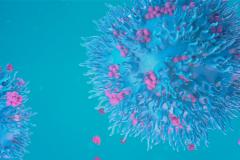Hydroxyzine is a first-generation antihistamine commonly prescribed in syrup form to infants and young children with itch-inducing skin conditions, such as atopic dermatitis and eczema. New research shows that the more hydroxyzine a child is prescribed, the higher their risk for developing a tic, anxiety, or conduct disorder.
During early childhood, the brain grows more quickly than at any other period in human development. Connections between brain cells rapidly form as children learn skills that will last a lifetime and set the stage for future learning. Experts call this a critical period of development because the brain is particularly vulnerable to environmental insults.
Some medications, called psychotropic medications, have the potential to act as environmental insults on the developing brain. These medications are called psychotropic because they are able to pass the blood-brain barrier and influence neuronal function.

The most commonly prescribed psychotropic medication for infants and toddlers in British Columbia is hydroxyzine, a first-generation prescription antihistamine with sedating effects. Hydroxyzine is typically used to treat itch-inducing skin conditions, such as atopic dermatitis, contact dermatitis and other eczema, and hives; allergy-related nasal congestion; and anxiety and nausea.
Concerned by the lack of pediatric safety studies on hydroxyzine and the growing body of research showing the importance of histamine as a neurotransmitter, Dr. Bruce Carleton, Dr. Kathy Li, Dr. Hans Gober, Kevin Yan, Dr. Anthony Bailey, and their colleagues recently investigated hydroxyzine’s safety when it comes to children’s neurodevelopmental outcomes. Their study was the first of its kind to report long-term neurodevelopmental effects of hydroxyzine.
“Previous research on pediatric use of hydroxyzine focused on drug metabolism and optimal dosage, but did not investigate neurodevelopmental safety or adverse effects besides sleepiness,” says Dr. Carleton. “We know there is an increased prevalence of atopic dermatitis and similar dermatological conditions in infants and young children, and hydroxyzine is so commonly prescribed to treat these conditions.”

Using medical databases in B.C. and a longitudinal study design, the team analyzed the prescriptions and diagnoses of more than 24,000 children who had been prescribed hydroxyzine between 1997 and 2018. Of these children, who ranged in age from birth to five, nearly half were prescribed hydroxyzine before the age of two.
The researchers found a way to represent cumulative exposure to hydroxyzine by looking at how many times the children had been prescribed the medication. 1,478 children received five or more back-to-back prescriptions, and this group was considered to have the most exposure to hydroxyzine. 5,659 children had received two to four prescriptions, and 17,324 had received only one prescription.
The team’s study design allowed for follow-up and analyses of prescriptions and medical diagnoses for each patient from birth to age 10. They were interested in three disease categories in particular: psychomotor disorders including tic disorder and hyperkinetic syndrome, learning deficiencies including intellectual disabilities and specific delays in development, and mental disorders including anxiety disorder and disturbance of conduct and emotions.
“We found that repeated use of hydroxyzine in young children, especially those with five or more prescriptions, was associated with elevated rates of tic, anxiety, and conduct disorders up to the age of 10, by odds ratios of 1.55, 1.34, and 1.34 respectively,” says. Dr. Carleton.
Controlled studies are now needed to show a clear causal relationship between frequency of hydroxyzine use and the incidence of tic, anxiety, and conduct disorders.
“We recommend alternative treatments for atopic dermatitis and similar conditions, such as second-generation antihistamines, topical antihistamines or corticosteroids, for preschool-age children,” says Dr. Carleton. “If hydroxyzine must be administered, we suggest the shortest possible duration.”
Read more in “Hydroxyzine Use in Preschool Children and Its Effect on Neurodevelopment: A Population-Based Longitudinal Study,” Frontiers in Psychiatry.




